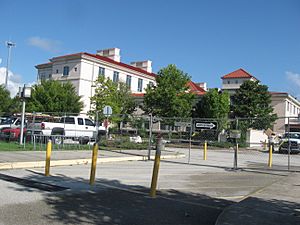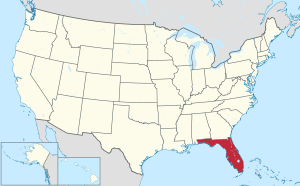St. Johns County, Florida facts for kids
Quick facts for kids
St. Johns County
|
|||
|---|---|---|---|

St. Johns County Courthouse
|
|||
|
|||

Location within the U.S. state of Florida
|
|||
 Florida's location within the U.S. |
|||
| Country | |||
| State | |||
| Founded | July 21, 1821 | ||
| Named for | San Juan del Puerto | ||
| Seat | St. Augustine | ||
| Largest community | St. Johns | ||
| Area | |||
| • Total | 822 sq mi (2,130 km2) | ||
| • Land | 601 sq mi (1,560 km2) | ||
| • Water | 221 sq mi (570 km2) 26.9%% | ||
| Population
(2020)
|
|||
| • Total | 273,425 |
||
| • Density | 455/sq mi (176/km2) | ||
| Time zone | UTC−5 (Eastern) | ||
| • Summer (DST) | UTC−4 (EDT) | ||
| Congressional districts | 5th, 6th | ||
St. Johns County is a county located in the northeastern part of Florida, a state in the United States. In 2020, about 273,425 people lived here. The main city and county seat is St. Augustine. However, the nearby community of St. Johns actually has more people living in it. St. Johns County is also part of the larger Jacksonville, Florida region.
The county was officially created in 1821. It was one of the very first two counties formed after Florida became part of the United States. This happened at the start of the Florida Territorial period. The county was named after the St. Johns River, which flows along its western side.
Many people who live in St. Johns County travel to Jacksonville for work. These areas are often called "bedroom communities" because people mostly live there and commute elsewhere for their jobs. Tourism is also a very important part of the county's economy. This is mainly because of the historic city of St. Augustine and the many golf courses in the area.
Contents
A Look Back: History of St. Johns County
The story of St. Johns County began in 1821. That's when Colonel Robert Butler officially received East Florida from Spain. He was representing Major General Andrew Jackson, who was in charge of Florida for the U.S. government. Jackson decided that all the land east of the Suwannee River would be named St. Johns County.
St. Johns County was created on July 21, 1821. This was just 11 days after Florida was given to the United States. It was also five days after the city of St. Augustine became an official city. At the same time, Escambia County was also created in the former West Florida area.
The name "Saint John's" came from an old Spanish mission built around 1580. It was called San Juan del Puerto, which means "Saint John of the Harbor." In 1932, the U.S. government removed the apostrophe from the name. This was because an apostrophe usually shows ownership, and they wanted the name to be simpler.
In the beginning, St. Johns County was huge! It covered most of peninsular Florida, more than 39,000 square miles. It was about 475 miles long and 165 miles wide. Much of this land was not inhabited. St. Augustine (founded in 1565) was the oldest permanent European settlement in the area. There were also many Native American communities living in the county.
County Symbols: Coat of Arms
St. Johns County has a special symbol called a Coat of Arms. It tells a story about the county's past.
- The main part of the design has a silver lamb (called an Agnus Dei) on a green background.
- The lamb holds a silver flag with a red cross. This is a direct symbol of the county's name, "Saint John."
- At the top, there's a red section with a gold castle. This castle has black lines for its stones and red windows and doors. It represents the strong fort built in St. Augustine, which is part of the county.
- Around the edge, there's a border made of eight parts. These parts switch between a red square with a gold castle and a silver square with a purple lion standing on its hind legs. These symbols come from the old coats of arms of Castille and Leon in Spain.
- At the very top, there's a special crown called a mural crown. It looks like a gold wall with twelve gold towers, though only seven are usually seen in drawings. This crown represents a province or region.
Where St. Johns County Is: Geography
St. Johns County covers a total area of about 822 square miles. Out of this, 601 square miles is land, and 221 square miles (about 26.9%) is water.
Nearby Counties
St. Johns County shares its borders with several other counties:
- To the north: Duval County, Florida
- To the south: Flagler County, Florida
- To the southwest: Putnam County, Florida
- To the west: Clay County, Florida
Special Protected Areas
The county is home to some important national protected areas:
- Castillo de San Marcos National Monument: A historic fort in St. Augustine.
- Fort Matanzas National Monument: Another historic fort, south of St. Augustine.
- Guana Tolomato Matanzas National Estuarine Research Reserve: A natural area that protects estuaries (where rivers meet the sea) and their wildlife.
Who Lives Here: Demographics
The number of people living in St. Johns County has grown a lot over the years!
| Historical population | |||
|---|---|---|---|
| Census | Pop. | %± | |
| 1830 | 2,583 | — | |
| 1840 | 2,694 | 4.3% | |
| 1850 | 2,525 | −6.3% | |
| 1860 | 3,038 | 20.3% | |
| 1870 | 2,618 | −13.8% | |
| 1880 | 4,535 | 73.2% | |
| 1890 | 8,712 | 92.1% | |
| 1900 | 9,165 | 5.2% | |
| 1910 | 13,208 | 44.1% | |
| 1920 | 13,061 | −1.1% | |
| 1930 | 18,676 | 43.0% | |
| 1940 | 20,012 | 7.2% | |
| 1950 | 24,998 | 24.9% | |
| 1960 | 30,034 | 20.1% | |
| 1970 | 30,727 | 2.3% | |
| 1980 | 51,303 | 67.0% | |
| 1990 | 83,829 | 63.4% | |
| 2000 | 123,135 | 46.9% | |
| 2010 | 190,039 | 54.3% | |
| 2020 | 273,425 | 43.9% | |
| 2023 (est.) | 320,110 | 68.4% | |
| U.S. Decennial Census 1790-1960 1900-1990 1990-2000 2010, 2020 |
|||
In 2020, there were 273,425 people living in the county. These people made up 91,253 households and 67,548 families.
Most people in St. Johns County are White. However, the county is becoming more diverse. Here's a quick look at the different groups of people living here in 2020:
| Group | Percentage in 2020 |
|---|---|
| White (not Hispanic) | 78.42% |
| Black or African American (not Hispanic) | 4.73% |
| Native American or Alaska Native (not Hispanic) | 0.2% |
| Asian (not Hispanic) | 3.57% |
| Pacific Islander (not Hispanic) | 0.06% |
| Other Race (not Hispanic) | 0.45% |
| Mixed/Multi-Racial (not Hispanic) | 4.3% |
| Hispanic or Latino (any race) | 8.27% |
In 2000, the average household had about 2.44 people, and the average family had about 2.90 people. About 23.1% of the population was under 18 years old. The median age was 41 years old.
Learning and Libraries: Education
Schools for Kids and Teens
Public schools in St. Johns County are managed by the St. Johns County School District. This district is known for being one of the best in Florida. It often gets top scores on the state's standardized tests, like the FCAT. The school system has grown a lot since 2000 because more and more families are moving to the county.
For the 2014–15 school year, the district had:
- 18 elementary schools (Kindergarten to 5th grade)
- 3 K-8 schools (Kindergarten to 8th grade)
- 7 middle schools (6th to 8th grade)
- 7 high schools (9th to 12th grade)
- 1 alternative center (Kindergarten to 12th grade)
- 6 charter schools (including a vocational-technical college)
- 1 virtual school
The St. Johns County School District also has a great department for special education. They help students with conditions like autism, cerebral palsy, and other learning needs. The Florida School for the Deaf and Blind is also located here. It's a special school for students who are deaf or blind, funded by the state of Florida. For private school options, the Catholic Diocese of St. Augustine runs St. Joseph Academy, a high school in St. Augustine.
From 2004 to 2014, St. Johns County schools consistently received an "A" grade from the state government for their excellent work.
Colleges and Universities
St. Johns County also has options for higher education:
- St. Johns River State College: This is a state college with a campus near St. Augustine. You can earn associate's degrees and some bachelor's degrees here.
- Flagler College: A private college in downtown St. Augustine. It's known for its liberal arts programs and has been recognized as a "Best Value College."
- University of St. Augustine for Health Sciences: This school focuses on training students for careers in physical and occupational therapy.
Public Libraries
The St. Johns County Public Library System has six different branches where you can find books, resources, and quiet places to study:
- Anastasia Island Branch
- Bartram Trail Branch
- Hastings Branch
- Main Library
- Ponte Vedra Beach Branch
- Southeast Branch
The St. Augustine Historical Society also has a research library for those interested in local history.
Museums to Explore
- Disease Vector Education Center: A museum where you can learn about insects and diseases they might carry.
Places to Live: Communities
Cities in the County
Towns in the County
- Marineland (partly in Flagler County)
Census-Designated Places (CDPs)
These are areas that are like towns but are not officially incorporated as cities.
Other Communities
These are smaller, unincorporated communities within the county.
- Armstrong
- Bakersville
- Elkton
- Julington Creek Plantation
- Mill Creek
- Ponte Vedra Beach
- St. Johns
- Spuds
- Summer Haven
- Switzerland
- Vermont Heights
Getting Around: Transportation
Airports
- Northeast Florida Regional Airport: This airport is located within St. Johns County.
- Jacksonville International Airport (JAX): A larger airport about 35 miles north in Duval County.
Major Roads
Several important highways run through St. Johns County, helping people travel around and to other parts of Florida.
 I-95
I-95 US 1
US 1
 US 1 Bus.
US 1 Bus. SR 9B
SR 9B SR 13
SR 13 SR 16
SR 16 SR 206
SR 206 SR 207
SR 207 SR 312
SR 312 Dixie Highway
Dixie Highway
Images for kids
See also
 In Spanish: Condado de San Juan (Florida) para niños
In Spanish: Condado de San Juan (Florida) para niños




